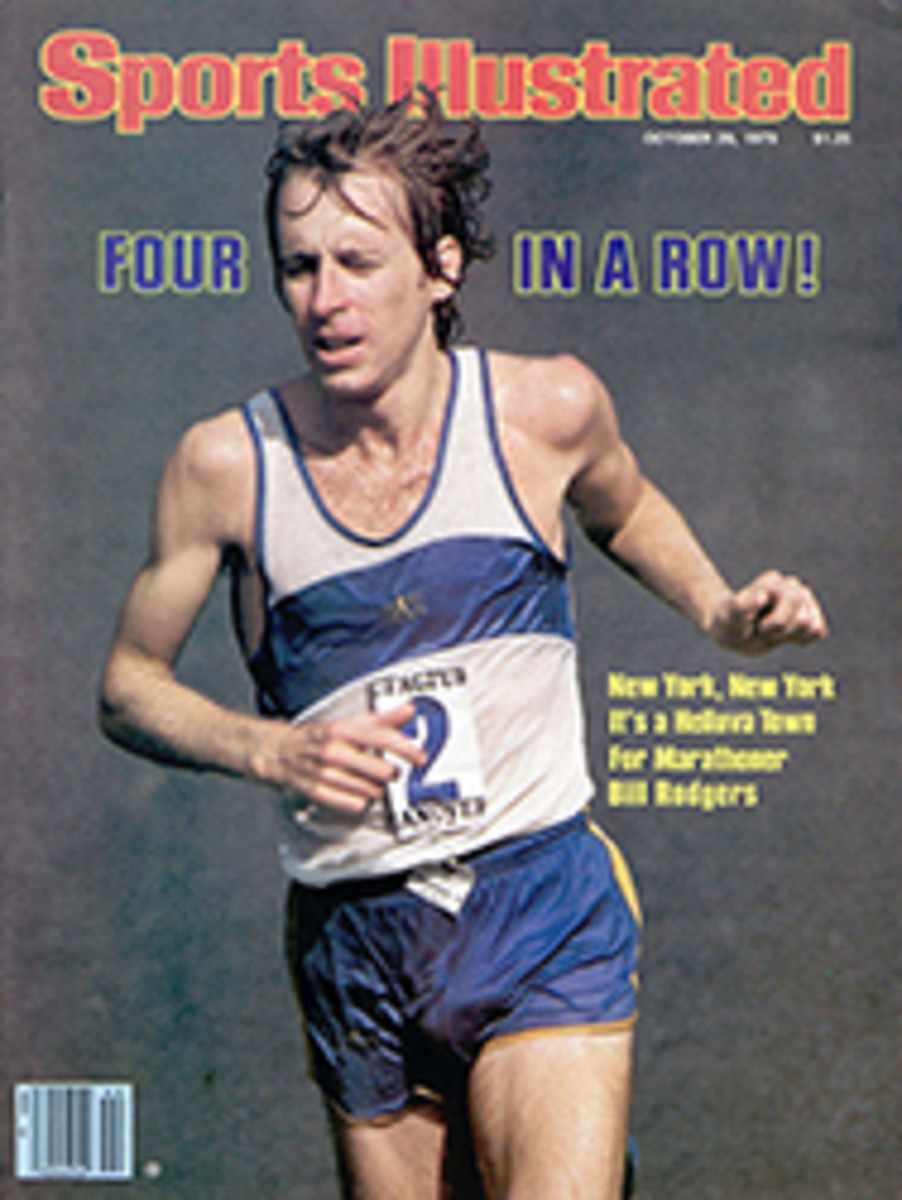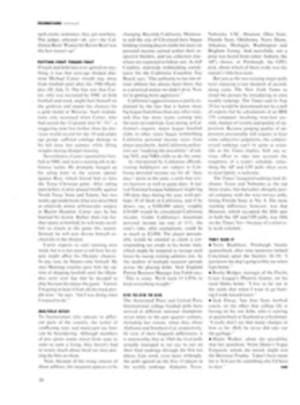
RUSH HOUR IN THE BIG APPLE
The New York City Marathon got under way last Sunday eight seconds before the starting cannon was fired. As the countdown to the gun began, an uncontrollable flood of humanity surged over the starting line on the Staten Island end of the Verrazano-Narrows Bridge, leaving four runners standing in place like rocks in the torrent—Bill Rodgers, Ron Hill, Jon Anderson and Kenny Moore. Friends on the sideline called to Anderson to begin, but he shook his head. Moore thought to himself, "Damn it, call them back." Hill said later, "I simply was going to start my run at the appointed time and had anyone who had sprinted out won, I would have protested."
When the cannon did go off and the race officially began, Rodgers, intent on the job at hand, began to pick his way through the huge, wobbling, lurching field from 150 yards back, demonstrating to every gun jumper he passed that, though bad sports may not finish last, they sure as hell were not going to finish first, not in this race.
The vehicles carrying representatives of the press and race officials, which preceded the runners, had been caught off guard by the surge and within seconds were engulfed and virtually immobilized. Frank Shorter, running between two of the vans, came perilously close to being crushed as harried drivers tried to maneuver through the mob.
No one in the mass of 11,553 runners, the largest field in the history of the race, bothered to look left for the view of the Manhattan skyline across New York Harbor that is supposed to make all those months of training worthwhile. Survival was the issue.
By the two-mile mark, where the bridge disgorges its traffic onto the streets of Brooklyn, the fearful starting mess had finally sorted itself out, miraculously with no injuries to show for the confusion, and everyone settled down to running for the finish, not their lives. Kevin Shaw of South Africa took the lead soon after the bridge. Behind him was a small pack, led by Benji Durden of Atlanta, that included Kirk Pfeffer and Steve Floto, both from Colorado, Zakaria Barie from Tanzania and Shorter, the 1972 Olympic champion, again in racing shape after a long, difficult recovery from surgery performed on his left foot in 1978.
If ever the long-awaited head-to-head marathon battle between Shorter and Rodgers was going to happen, this year's New York race seemed the time and the place. Shorter was apparently close to his old form, which enabled him to win nine of 10 marathons he entered during one stretch in the early 1970s, and Rodgers seemed somewhat less invincible than he had been for the past three years. After his 2:09:27 triumph in Boston in April, Rodgers went into what looked suspiciously like a slump that reached its nadir when he finished 15th at the World Cup Marathon in Montreal in August. "Just wait till the fall," said Rodgers then. "The fall is when I get serious." Still, some folks thought his nearly weekly schedule of races may have taken too great a toll.
Also favoring a close Rodgers-Shorter battle was the weather. Rodgers hates heat; Shorter hates cold. Rodgers sweats like a skinny pig if the temperature is over 60°; Shorter cannot get warmed up if it is below that. Weather that is right for one is usually entirely wrong for the other. But Sunday in New York dawned cool and foggy, and at 10:30 a.m., race time, the temperature was still only 64°.
As events in Brooklyn started to take shape, however, it appeared the match race would be postponed again. Shaw was still leading after six miles, having run that distance in 28:52, but his sub-five-minute pace was not one he could maintain. At slightly less than eight miles, as the blue line guiding the runners crossed Flatbush Avenue and started up the long Lafayette Avenue hill under an arch of autumn-leafed trees, Pfeffer, a lanky 21-year-old graduate of the University of Colorado, took over.
Cryptic messages on homemade banners spanned Bedford Avenue as the leaders passed through Bedford-Stuyvesant. FIRE FIGHTERS RUN IN HEAT said one of them. At 10 miles Pfeffer was still extending his lead. His time as he entered Williamsburgh was 48:21, but the pious Hasidim on the sidewalks, somber of dress and demeanor, only stared as the tall, thin blond streaked through their latter-day shtetl.
As he ran through Greenpoint, where signs in Polish shop windows still welcomed Pope John Paul II, and over the Pulaski Bridge into Queens, Pfeffer looked ever the more uncatchable. At the halfway point his time was 1:03:51, a course-record pace, and his lead was more than 400 yards. When he reached the Queensboro Bridge, which spans the East River between the industrial grit of Long Island City on the Queens side and Oz on the other, he had built himself a 1½-minute edge.
However, going up the steep ramp of the lacy old bridge he slowed visibly, and it looked for the first time as if he might be laboring. The sun broke through as he approached the Manhattan side, where spectators holding balloons and drinking Bloody Marys waved at him from the terraces of $1,000-a-month apartments. Coming off the bridge into the warm embrace of the huge cheering crowds lining First Avenue, Pfeffer maintained his lead, but finally, behind him, Rodgers was beginning to make things happen.
Rodgers had teamed up at the two-mile mark with the English middle-distance runner, Steve Kenyon, and the two had worked their way through the field together. "Steve had a watch and we paced each other," said Rodgers later. "He knew many of the European guys, so he could identify them for me. He'd point and say, 'That's so-and-so,' and tell me what he'd done in races, and then we'd pick them off, one at a time."
In this almost cruelly efficient manner, Rodgers made his way through the crowd until finally, at the 21-mile mark, in the Bronx, he saw Pfeffer. "I didn't even know he was in the race until 15 miles," said Rodgers.
Coming back into Manhattan and down Fifth Avenue and through Harlem, Pfeffer was tired and looking it, while Rodgers, his blond hair dark with sweat and his right arm characteristically flailing, drew ever closer. In Central Park, at 23.3 miles, Rodgers finally passed Pfeffer and cruised in from there for his fourth consecutive victory in the race.
"When I caught him I stayed with him for a bit," said Rodgers. "He was tired. When I reached him, it took him a while just to turn his head and look at me."
Rodgers had run exactly the kind of race he wanted to run, at a pace he could maintain and still have something in reserve against heat from above or behind, neither of which materialized. He finished in 2:11:42, a minute and 33 seconds behind the course record he had set in 1976 but 1:26 ahead of the struggling Pfeffer, who, it turns out, had entered the race on a whim.
"I was going to run Fukuoka [Japan] in December," Pfeffer said dejectedly. "I may still. But I was lying in bed yesterday morning at home, thinking of this race, thinking, 'I can win that thing.' I felt kind of left out, you know. So I caught the first plane and was here by two in the afternoon."
Kenyon finished third, in 2:13:29, and was happy, though until he reached the finish line and saw Pfeffer for the first time, he had thought he was second. Shorter was seventh in 2:16:15, his best marathon since this race in 1976.
All of them were near the finish line, and Rodgers, at least, was cheering when Grete Waitz, the Norwegian schoolteacher who insists she has always been, is now and ever will be a track runner, not a marathoner, crossed the finish line in 2:27:33, almost five minutes faster than the world record she set last year in New York, and 11 minutes faster than any other woman in the race. Only three days earlier she had predicted, when pressed, that in a few years women would probably be able to run a 2:28 marathon. "I went out faster this year," she said. "Last year I knew absolutely nothing about marathons, so I kept back in a pack with some other girls. At about 13 miles I saw I had a 1:14, and I knew if I kept it up I might get 2:28 or 2:30. But I didn't expect 2:27."
"She's pretty outrageous," said Rodgers admiringly. "I saw her come across the line, and, well, she's inspirational."
Last year, when Waitz set her first world record in her first marathon, nobody, including the announcer at the finish line, knew who she was. This year she spent hours signing autographs wherever she went.
"I was a little disappointed Joan Benoit and the other girls did not show up here," Waitz said, referring specifically to the American record holder and winner of the 1979 Boston Marathon. "It is not good to be afraid of me. You can't be a better runner unless you are willing to be beaten. That's how I feel. If I am beaten, I say, 'O.K., you're better than I am, but next time I try to beat you.' " For the present, it is difficult to imagine Waitz being beaten at all.
The guest of honor in Central Park, as many of the best marathon runners in the world crossed the finish line, was the greatest distance runner of all time, 57-year-old Emil Zatopek of Czechoslovakia. Twenty-seven years after he won the 5,000, the 10,000 and the marathon at the Helsinki Olympics, Zatopek is still brimming with life and health, a joyous figure who on seeing New York for the first time marveled aloud at everything.
"My feeling a couple of years ago, when I learned how big this race is, was that it was incredible, impossible to organize. I showed a list of last year's 10,000 finishers to people in Czechoslovakia and they said, 'No, it's some kind of trick.' "
But after witnessing the enormous spectacle, it was Zatopek who put it into perspective: "It's just good to see this running, this most natural motion, be enjoyed by so many. It's medicine, I think, good for whatever is wrong with you."
PHOTO
PHOTO
Below the dispersing fog, a long column of marathoners streamed up Manhattan's First Avenue.
PHOTO
A feline fan watched some fast cats go by.
PHOTO
Waitz lowered her world-record time by 4:57.

